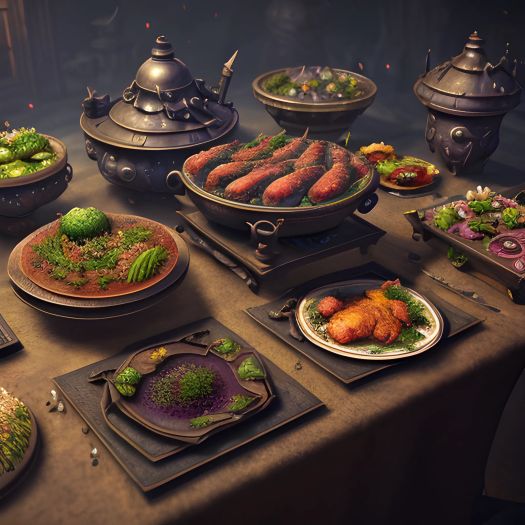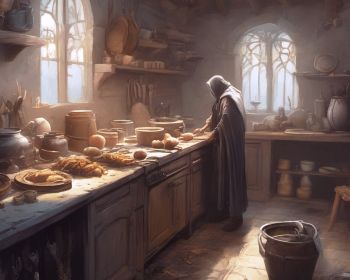Nutrition & the Preparation of Food
Nutrition and Preparation argues that the food consumed in the game world should vary in kind, so that apart from the amount of food that characters must consume, the taste and quality of the food should also matter. Characters cannot simply live on bread and water. They must eat, at the very least, "palatable food" — and, when possible, "good" food.
Contents
This isn't always easy while adventuring. The manner of food that can be obtained, and where it can be prepared, improves considerably in urban settings, where an interior kitchen is available. Food cooked in a camp, which must endure in a character's pack for days, is far less desirable and the value gained from eating such victuals deserve attention within the game's rules.
Food Goodness
A food's versatility and taste depends upon it's general caliber. Ordinary food, while resistant to spoiling, has little to offer as a meal, if not blended with more discerning or quality foods. Thus the "goodness" of a food describes it's capacity to entice the senses. There are five general standards of goodness: durables, staples, fresh foods, premium foods and delicacies.
Durables
These include preserved meats such as jerky, dry sausage, salt-pork, sauerkraut and dried fish; also potable plant products like polished rice and dried pulses; and forage such as dried mushrooms, grains, wild nuts, seeds and dried fruits. Food that is foraged falls into this category. Note that the category includes mainly unprepared foods, whereas "staples," below, include versions of these foods after processing. Durable foods may be edible after months have passed, and even years.
Staples
These include processed foodstuffs such as flour, refined salt, honey, cheese, butter and biscuits, root vegetables and tubers, and beverages such as ale, beer, mead, wine and distilled drink. The inclusion of these latter beverages especially raise the quality of the meal. As products, they generally have a lifespan of 2 to 8 months.
Fresh Foods
These include recently picked vegetables and fruits, butchered meats, whole or raw milk and cream, among others. For each there is a short time before the food spoils, before it is processed or cooked — in some cases as little as 2 days, in others as much as 12 days. Meanwhile, the wholeness of the food is in a state of constant decline, but may be "rescued" even after it's begun to go bad. Also included in the category, and having longer lifespans, are herbs such as basil, chamomile, cumin, dill, rosemary, parsley and sage, along with tea leaves and coffee beans. Note that in all cases, very fresh foods are considered "premium."
Premium Foods
These include fresh foods that have been picked or collected in the last 12 hours, including butchered meats. These also must be of the best nature, without bruising, blemishes or discolouration, and with regards to meat, butchered finely and from the choice parts of the animal. Premium foods that are allowed to linger become "fresh" when the 12-hour time period has past.
Delicacies
These include unusual dishes or foods that provide a complex dining experience, such as caviar, foie gras, eels, turtle, cicitt, suckling pig and many others. Unusual distilled spirits or wines also fall into this category. Each has a variable shelf life, though many are pickled or otherwise preserved due to their being transported over long distances.
Preparation
There are six "standards" of preparing food, specifying limitations of space, utensils and equipment, the nature of the fire used and complimentary storage of edibles. Though a cook's hands are undoubtably the most important, having room to work in a fully equipped kitchen, where the air is kept fresh while particulates are kept to a minimum, are unquestionably necessary to the preparation of great dishes. Thus the circumstances in which food is prepared subsequently affects the diners' health and mood.
Cold Camp Fare
This describes eating in the outdoors, effectively cooking in one's lap, without the benefit of fire or any other heat source. Methods focus on combining raw or minimally processed ingredients creatively to create dishes. This allows food to be cleaned with water and peeled, through the use of a knife or a scraping rock — and so food that is pounded, mashed or cut up is possible. However, without a fire, food cannot be safely blanched or boiled, nor can it be browned and sweetened.
Durables and staples, along with fresh vegetables, fruits, and bottled beverages, are best for cold camp cooking. Spices can be used but they have only a moderate effect on the food's taste. Meat must be eaten raw, for which fish is best. Some delicacies that have been pickled can be eaten in a cold camp, but without other viands this would be a dreadful waste of expensive foods. Meals in a cold camp can be satisfying, but it takes a clever culinary authority to make them so.
Campfire Fare
This allows the benefit of cooking over an open fire, utilising the heat and flames to sear or bring out the juicier flavour of foods. The practice requires careful management of the fire and cooking tools. Cooks may employ pans or flames to stew and boil foods, making soups, sauces and fried dishes. Meats may also be wrapped in leaves, bark, husks or even mud clay as a means of baking. Most preparation is done on a rock or upon a board set into the ground; tools are cleaned with boiled water and lye.
Galley Fare
This describes victuals that can be prepared in a cramped space, which creates a challenging but vastly improved experience over a campfire. The practice necessitates careful organisation and adaptability, to avoid injury in close quarters with the fire while successfully producing a meal. Situations include cooking in a rolling cookwagon or vardo, or a ship galley, with compact appliances and utensils.
Fires are kept in a raised, open brick or stone box, with some sort of opening above, or attached to the outside of vehicle or dwelling. A flue is employed in special circumstances. Aboard ship, arrangements are made to allow the fire to be dumped quickly, through a port in the ship's hull, should a battle arise — in which case, until the fire can again be allowed, the crew must be limited to effectively cold camp fare. Fresh and premium foodstuffs are rare aboard ship during voyages.
Scullery Fare
This describes meals that can be cooked in a simple kitchen that would occur in a common home cottage. Such features basic tools and equipment necessary for preparing food during the game's era, reflecting a rustic and practical modest space. Included would be a small fireplace and chimney, counters, a large washbasin, bins for various staples and durables, bottles, a cold storage and space for more than one large pot. A cook's knife and a few other objects might be all a farmer could afford, but these could be augmented by a wealthier character.
A "scullery," or place for washing dishes, might be attached to the exterior of the hours or simply count as a corner of the cottage kitchen. In any case, the cooking and cleaning spaces allow for a considerable number of dishes to be made, but limitations on truly elaborate methods such as deglazing, braising, curing & smoking, large-scale marination and so on would be difficult.
Guestkitchen Fare
This describes a truly spacious arrangement in which a wide variety of sinks, pots and pans, cooking tools and cutting spaces are available, as well as a wide hearth with spit, gridiron and cauldrons. Rustic wooden tables each have a specialised use. A separate but attached scullery is definitely present. Provided with excellent ventilation, a guestkitchen is designed to cook multiple meals at once, for scores of people at a time, and thus is typical in the best public houses.
Room for multiple cooks and preparers is available, creating a bustling and sometimes cluttered space due to the persons available and amount of rush to produce food. The atmosphere is characterised by warmth, aromas and the clatter of pots and pans. Bundles of dried herbs are hung from the walls, while various foods are stuffed into pantries or cold storage. Water and other beverages can be accessed from barrels, which take up much space.

